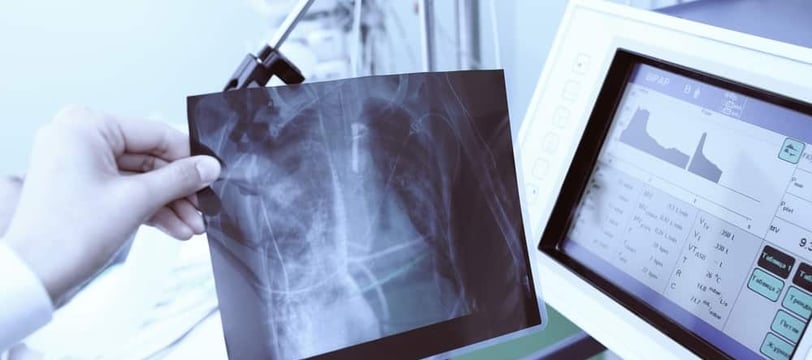Understanding the Impact of High-Resolution X-ray Systems on Diagnostics
In the ever-evolving world of healthcare, the accuracy of diagnostics plays a crucial role in determining patient outcomes. X-ray imaging, one of the oldest and most widely used diagnostic tools, continues to be a cornerstone of medical imaging. However, advancements in technology have transformed traditional X-ray machines into high-resolution X-ray systems that offer unprecedented levels of clarity and detail. High-resolution X-ray systems are making a significant impact on the diagnostic process, improving both the accuracy and speed of medical imaging. In this blog, we’ll explore how these advanced systems are changing the landscape of diagnostics and enhancing patient care.
3/20/20253 min read


What is a High-Resolution X-ray System?
A high-resolution X-ray system is a modern diagnostic tool designed to capture detailed images of the inside of the body with incredible clarity. These systems use advanced digital radiography (DR) technology, which converts X-rays into digital signals. The result is a much sharper and clearer image compared to older film-based X-rays or traditional imaging methods.
The key feature of high-resolution systems is their ability to capture more fine details in the images, providing clinicians with a more comprehensive view of the anatomy. This includes small structures like bone fractures, tiny tumors, or subtle changes in tissue density that could be missed with lower-quality imaging systems.
How High-Resolution X-ray Systems Impact Diagnostics
Increased Diagnostic Accuracy
The most significant impact of high-resolution X-ray systems is the improvement in diagnostic accuracy. With enhanced image quality, healthcare providers can spot abnormalities that might have gone unnoticed with older or lower-resolution technology. For example:
Fractures and bone conditions: Subtle fractures, especially hairline fractures, can be hard to detect with traditional X-rays. High-resolution X-ray systems reveal minute details of bone structures, ensuring that even the smallest cracks are visible.
Tumor detection: In the early stages of cancer, tumors can be very small and difficult to identify. High-resolution imaging allows for the detection of smaller lesions, improving the chances of early diagnosis and treatment.
Dental and skeletal imaging: In dentistry, for instance, high-resolution X-rays can help detect cavities, infections, or changes in bone density at much earlier stages than traditional methods.
By providing a more detailed view, high-resolution X-ray systems enable healthcare professionals to make more accurate diagnoses and devise better treatment plans.
Early Detection and Better Patient Outcomes
One of the most profound benefits of high-resolution X-ray technology is its role in early detection. Detecting diseases and conditions in their earliest stages significantly improves the chances of successful treatment and recovery.
For example, when small lung nodules or early signs of osteoporosis are detected using high-resolution X-rays, treatment can begin sooner, often resulting in better outcomes for the patient. In addition to better patient outcomes, early diagnosis can also lead to reduced treatment costs as interventions can be less invasive and more affordable.
Reduced Need for Repeat Imaging
In many cases, traditional X-ray systems may require multiple images or repeat scans to obtain a clear enough view for accurate diagnosis. This not only increases patient exposure to radiation but can also delay diagnoses and treatments.
With high-resolution X-ray systems, the images produced are of such superior quality that healthcare providers often require fewer scans to get the necessary information. This leads to:
Lower radiation exposure for patients
Faster diagnosis and treatment
More efficient use of medical resources
Improved Workflow and Efficiency
Modern high-resolution X-ray systems are designed with digital capabilities that streamline the entire imaging process. This includes faster image processing times, better image manipulation, and seamless integration with Picture Archiving and Communication Systems (PACS).
For healthcare facilities, this means that radiologists can instantly view, manipulate, and share high-quality images across departments, improving collaboration and speeding up decision-making. The ability to access images quickly ensures that healthcare providers can act promptly, reducing wait times for patients and improving overall efficiency.
Enhanced Patient Safety
High-resolution X-ray systems contribute significantly to patient safety by reducing radiation doses. In traditional X-ray imaging, higher radiation levels were often required to achieve a clear image, increasing the potential risks associated with radiation exposure.
Newer digital systems, however, use advanced algorithms and software to optimize the image quality while using lower radiation doses. This ensures that patients receive high-quality diagnostic images with minimal risk. The focus on reducing radiation exposure makes high-resolution X-ray technology not only more effective but also much safer for patients.
Better Image Quality in Challenging Situations
High-resolution X-ray systems also excel in complex diagnostic situations. For example, in pediatric radiology or imaging of patients with obesity, where clear imaging is challenging, advanced X-ray systems offer better resolution and the ability to capture more accurate images.
In these situations, high-resolution imaging systems help to ensure that diagnostic accuracy is maintained regardless of patient conditions. This level of adaptability is crucial for providing optimal care for all patients.
The Future of High-Resolution X-ray Technology
The future of high-resolution X-ray technology looks incredibly promising. As imaging systems continue to evolve, we can expect even higher-quality images, further reduction in radiation exposure, and more advanced tools for automated analysis using artificial intelligence (AI). AI integration will likely allow for faster identification of abnormalities and even more accurate predictions of disease progression.
Moreover, high-resolution imaging is paving the way for new applications in preventive medicine, such as routine screenings for cancer or cardiovascular diseases, where early detection could make a life-saving difference.


Reference Website Links:
Radiological Society of North America (RSNA) - Advances in Imaging
https://www.rsna.org/American College of Radiology (ACR) - Radiology Resources
https://www.acr.org/Carestream Health - Digital X-ray Technology
https://www.carestream.com/National Institute of Biomedical Imaging and Bioengineering (NIBIB) - X-ray Imaging
https://www.nibib.nih.gov/science-education/science-topics/radiologyWorld Health Organization (WHO) - Medical Imaging
https://www.who.int/health-topics/medical-imagingMIT Technology Review - X-ray Imaging Innovations
https://www.technologyreview.com/
